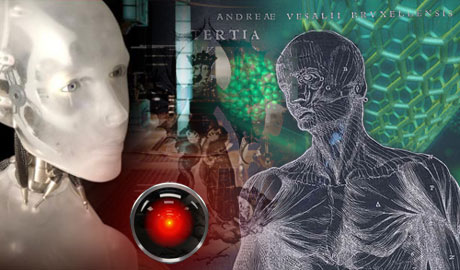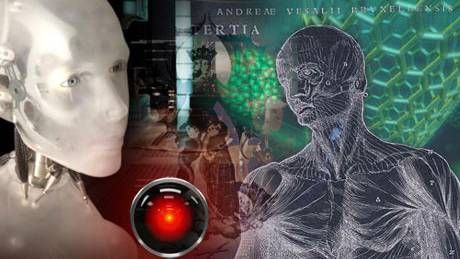Transgressive technologies: Does a posthuman dystopia await us?
Source: enterstageright.com

There are a number of highly transgressive technologies on the horizon of development today, which may prove to be the most fundamental challenges ever to the notion of a more stable human nature, and thereby, to what can seen to be "natural" to humankind. Such technologies can be a vehicle for the almost indefinite perpetuation of "the unnatural," never allowing today's societies to "catch their breath" and possibly return to earlier, sounder bearings. For example, in the book, Posthuman Bodies (edited by Judith Halberstam, Indiana University Press, 1995), a group of ultra-radical, postmodern writers and scholars, looks forward to the deconstruction of actual physical gender which could occur as a result of advancing technology. They talk of such things as men literally being able to bear children, as well as a "transgendered" existence across a "spectrum" of variants. A "posthuman" artistic movement depicts gross interpenetrations of machine and man. In one of his more recent books, Our Posthuman Future: Consequences of the Biotechnology Revolution (Farrar, Straus, and Giroux, 2002) the uber-pundit Francis Fukuyama has profoundly warned of some of the social dangers of genetic engineering.
The Internet is a primary focus for technological advance today. It is difficult to see what the longer-term intellectual impact of the Internet might be. While on the one hand, it could encourage the flourishing of varied philosophical debate, it could just as easily encourage varied kinds of depravity. One wonders if it simply won't serve to perpetuate the current consumerist, materialist society.
Further in the future is the prospect of Virtual Reality (VR). The ultimate goal of today's massive, frenzied attempts to develop VR is often semi-jokingly said to be the prospect of virtual sex with pop-icon Marilyn Monroe. VR (perhaps similar to the so-called "holodeck" which appeared in Star Trek: The Next Generation) can be understood as highly addictive electronic stimulation. The incredible popularity of Nintendo and similar videogames, with what could be considered "primitive" technology -- relative to what awaits in the future -- is an obvious warning as to the spiritual disfigurement that could result. The Matrix movie series has darkly portrayed the combination of the ultimate extension of VR and Artificial Intelligence (AI), both now in embryonic form.
VR offers the idea of solipsistic self-creation where the notion of human nature and natural limits has been utterly abolished. The computer-generated images often purveyed in current-day sci-fi movies (and television programs, especially the new crop of "cyber" programs for children) are often grotesquely unnatural, transgressive, and rather horrific, especially if considered in relation to those sights regularly to be seen in the human and natural worlds. They strongly project a gnostic, pseudo-spiritual transcendence of the material world…
VR is obviously linked to the postmodern (or hypermodern) notions of radical autonomy, and of continual self-construction and reconstruction, unhampered by God, nature, or history. The notion of the radically disembodied self (divorced from family, history, religion, and indeed, human as well as physical nature) is inevitably amorphous. While elevating individualism above all else, the late modern self becomes a shallow, banal construct, filled with mass-media images and concepts, often of the lowest common denominator. So it could be argued that the individualism of late modernity actually leads to an atrophy of true individuality and character, and the submersion of most people in a series of very low, herd or mass-mentalities and pseudo-collectivities, and to a thoroughgoing revolt against what could be considered the natural.
The notion of VR is linked to the tendency of immersion and immersive media today. The electronic media is already tending to becoming a very powerful, autonomous realm. The massive merger of AOL and Time Warner – although it turned out to be rather financially disappointing -- pointed to the meld of form and content, driving towards one megamedium. It has been suggested that increasing "broadband" on the Internet, which will allow for continual audiovisual images, will actually "dumb it down" – in the direction of becoming "just another television." Indeed, the continuation of a "smarter" use of the Internet -- as opposed to various types of graphical amusements – will be a constant struggle for many people. Many people will indeed have to resist the media and society-wide tendencies to what amounts to turning their computer into another television. It could be argued that the information traffic most people are caught in today often results in a "postmodern blur" of existence and reality.
The media structures today are further strengthened by the vertical integration in pop-culture industries. Thus, videogames may produce films or books based on the game, films may produce electronic games based on the film, and so forth. This vertical integration is a factor strengthening "the gatekeepers" of the media industries, as it is always the same image (whether in film, electronic game, print, toy, or fashion media) that is being replicated. This replication of images places the so-called "border-dwellers" – those who try to introduce more idiosyncratic images, in a weaker position. "Border-dwellers" typically have to spread their message across various eclectic media. However, what one finds is that many persons simply replicate the main images of the media giants in somewhat less-well-crafted form.
Another danger which awaits today is what could be called the pharmacopia -- the continuing development of pharmacological narcotics, stimulants, and hallucinogens, which create a state of addictive stimulation. This is often coupled with surreal music and sound and light effects at so-called "raves," semi-clandestine multi-hour dance-parties, where the taking of the drug called Ecstasy (MDMA) is virtually de rigueur. The "rave" experience, fairly common among some young people, is already quite close to VR. Large numbers of highly addictive, highly enrapturing, chemical and plant substances, are supposedly illegal, yet are fairly easily available to young people or most others who wish to find such substances. But a greater danger may become a generally-available "feel-good" drug (such as the "soma" of Aldous Huxley's Brave New World), which may kill the possibility of "the true spiritual" in human beings, because of the constant feeling of satiated comfort it gives.
The third danger is the extension of the body-piercing and body-transforming concept to ever-more transgressive levels. Some aspects of this visible today are the overindulgence in cosmetic operations; the grotesqueries of hyper-muscle-building (almost always enhanced by drugs, such as steroids); the phenomenon of "sex-change" surgery; and increasingly transgressive body-piercing. This may culminate, for example, in various types of extreme body-piercing, tattooing, and branding, by comparison to which a small nose-stud will seem tame.
The fourth main danger is genetic subversion, which some call by the trendy name "algeny" (from alchemy). What this might mean is increasing inter- as well as intraspecies genetic engineering, including the attempt to create new lifeforms. The advances in genetics will be initially powered by the promise of eliminating hereditary defects in the womb, which few people will probably object to (i.e., to produce a physically healthy child, rather than one afflicted with severe disability). They will also be powered by the desire to create replacement body parts, for an increasingly aging population. Some of these trends can already be seen in the mice produced for scientific research, which have genetically human blood flowing through their little bodies, as well as "transgenic" pigs, whose organs are to be used as substitutes in humans. A possible extension of these concepts would be the production of brainless fetuses, who grow in a woman's womb for the sake of the organs they would later supply. A similar concept is to clone a brainless twin from every normal baby born, where the former would be maintained only as supplier of fresh organs for the latter. There has been an incredibly intense debate over stem-cell research, as human embryos are usually considered to be the main source of stem cells. Some researchers, however, have tried to identify and work with stem cells from adults, which neither harms the adult person, nor requires the destruction of embryos. In November 2001, there was the announcement of the cloning of a human embryo. It was said about the procedure that it would be used only for “therapeutic” purposes, i.e., to harvest stem-cells that could be later be grown into substitute organs – rather than to try to replicate a whole new person.
Geneticists have also experimented with splicing the genes of mice and carrots, and creating "monstrous" flies, with eyes in places where they never naturally occur. Genetic engineering could be seen to hold the peril of human extinction within itself. Suppose genetic engineers develop an oil-eating bacteria, to deal with oil slicks, which somehow mutates into having a preference for human blood! There is a fundamental genetic threat to humanity from ostensibly positive motives, and not only from such obvious things as biological warfare exercised by some rogue country's or terrorist faction’s fanatical leaders.
It has been suggested that because of the increasing prevalence of estrogens and other chemicals in the environment, there are occurring drastic declines in men's virility, especially in Western countries, as well as the far quicker onset of characteristics of puberty in young girls. At the same time, there is an explosion of obesity-related diseases, as the percentage of obese persons continues to grow. Cancer rates are also burgeoning, most likely because of the increasing poisons in the food, water, air, and earth. The increasing prevalence of prostate cancer in men, and breast cancer in women, is probably environmentally-related.
Food produced by modern industrial methods and involving genetic modification often appears to be carcigenous; yet a return to more organic methods of farming (and avoidance of genetic modification techniques) is now difficult, since the food supply would likely drop so rapidly, hundreds of millions of people would probably be pushed to the edge of starvation. However, the extreme industrialization of food production, for example, by feeding cattle the ground-up remains of their own species -- has resulted in mad-cow disease. These industrial methods are accompanied by massive use of artificial growth hormones and antibiotics, because the cattle no longer eat grass in the fields, but are continually penned up.
The story of modern medicine and technology is indeed one of initial fantastic success, which has, it could argued, nevertheless stalled in the last few decades. Indeed, one can see a hypertrophy of advance, a law of diminishing returns, in the current-day fight for health. The health-consciousness of a few is magnified through the media highlighting "beautiful people" and sport-stars, whereas the spectator public grows ever less healthy and overweight.
As modern medicine carries out evermore advanced and seemingly miraculous procedures, the possibilities of dangerous manipulations also increase. What is not often noted is that many birth defects today arise from the polluted environment, as well as sometimes from the manifestly unhealthy lifestyles of one or both parents; i.e., extraordinary technological interventions are now possibly required more frequently as a result of what could be characterized as other forms of "progress." It can also be noted that because of over-use of antibiotics, fearsome new strains of disease are making a comeback.
The fifth main crisis is that of environmental degradation. Overpopulation, industrial pollution, drastic changes in weather patterns, and the reduction of biodiversity (sometimes through the introduction of certain non-native animal and plant species) are often interrelated phenomena. Various parts of the world are now increasingly threatened with extreme weather (such as floods and fires) as well as insect and plant plagues and pestilence. The arrival of the West Nile virus in North America has been well-documented. The planet’s biosphere is a complicated system, and late modern human actions may be putting inordinate stresses on it. By the time humanity realizes it has seriously damaged Earth’s climatological system, it may have passed the point of being fully reparable. The weather may well continue to become ever more extreme and unbalanced. Extreme weather, crop failure, and pestilence, may cause vast increases in the number of people facing starvation. However, as conditions worsened, humanity could presumably still take the steps that would avoid truly disastrous outcomes – such as the so-called “planet Venus scenario” – where global warming would become open-ended and irreversible.
Another possible danger is nanotechnology, which, although today in its infancy, is now taken as standard in many science fiction futures. Nanotech is the notion of micromachines, which take the role of keeping human beings, and possibly animals, plants, and the entire environment in good health and shape. One way this might work is that when a baby is born, he "gets introduced" to his own batch of "nanotech warders" -- i.e., these micromachines that will help him avoid disease, and grow up stronger, healthier, and perhaps more intelligent than he would otherwise be. The possibilities of misuse of nanotech are obvious -- nanotech programmed to torture or kill, or to massively alter one’s mental perceptions, or the possibility of a widespread nanotech "virus" or "plague," that could possibly extinguish humankind and even all natural life – the so-called “gray goo” scenario. This was one of the main concerns – along with the emergence of AI that would replace mankind, and the perils of genetic manipulation -- raised in Bill Joy’s important article in the April 2000 issue of Wired. As Chief Software Architect of Sun Microsystems and co-inventor of both Unix and Java Script, he cannot be so easily dismissed as a neo-Luddite. In November 2001, it was announced by an Israeli laboratory that it had created a “DNA-based computer” – a convergence of biotechnology and nanotechnology.
Moving beyond nanotech, one comes to the possible ultimate extension of the Internet -- the ability for persons to upload their "consciousness" into an electronic virtual reality realm. This is perhaps similar to what the radical theologian Teilhard de Chardin called the noosphere. There have been a number of science fiction books written which suggested that only religious-minded people would resist the prospect of such an unprovidential quasi-immortality. However, it does appear that the very complexity of the human brain (with its hundreds of billions of synapses or "links") will prevent the possibility of the meaningful, physical "uploading" of consciousness into a mechanical construct.
Article from: http://www.enterstageright.com/archive/
articles/1107/1107transtechp3.htm






















